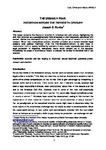The Unmanly Fear: Extortion Before the Twentieth Century
| dc.contributor.author | Bonica, Joseph S | |
| dc.date.accessioned | 2017-03-20T15:53:56Z | |
| dc.date.accessioned | 2017-04-11T08:44:33Z | |
| dc.date.available | 2017-03-20T15:53:56Z | |
| dc.date.available | 2017-04-11T08:44:33Z | |
| dc.date.issued | 2013 | |
| dc.identifier.citation |
Bonica, J.S. (2013) ' The Unmanly Fear: Extortion Before the Twentieth Century', Law, Crime and History, 3(2), pp.1-29. Available at: https://pearl.plymouth.ac.uk/handle/10026.1/8879 | en_US |
| dc.identifier.issn | 2045-9238 | |
| dc.identifier.uri | http://hdl.handle.net/10026.1/8879 | |
| dc.description.abstract |
This essay concerns the history of extortion in American law and culture, highlighting the shift from extortion as a paradigmatically male enterprise to one inseparably associated with women. Before the nineteenth-century, extortion was figured as an assault on a victim’s consent. Since men monopolized consent, extortion unfolded as a contest between legal subjects over political manhood. After the mid-nineteenth-century, a new class of ‘respectable’ victims, openly terrified by women’s threats, made unprecedented claims for legal protection. In response, well-placed courts wrote consent out of the equation, broadening the scope of extortionous threats to unleash the familiar fin-de-siècle tide of sex scandal. | en_US |
| dc.language.iso | en | en_US |
| dc.publisher | University of Plymouth | |
| dc.rights | Attribution 4.0 International (CC BY 4.0) | * |
| dc.rights.uri | https://creativecommons.org/licenses/by/4.0/ | * |
| dc.subject | extortion and law relating to | en_US |
| dc.subject | blackmail | en_US |
| dc.subject | sexual blackmail | en_US |
| dc.subject | gendered power | en_US |
| dc.subject | consent and coercion | en_US |
| dc.title | The Unmanly Fear: Extortion Before the Twentieth Century | en_US |
| dc.type | Article | en_US |
| dc.type | Article | |
| plymouth.issue | 2 | |
| plymouth.volume | 3 | |
| plymouth.journal | SOLON Law, Crime and History |



